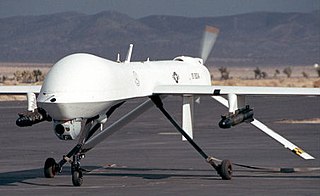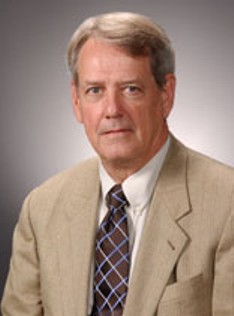Related Research Articles

The Defense Advanced Research Projects Agency (DARPA) is a research and development agency of the United States Department of Defense responsible for the development of emerging technologies for use by the military.

A robot is a machine—especially one programmable by a computer—capable of carrying out a complex series of actions automatically. A robot can be guided by an external control device, or the control may be embedded within. Robots may be constructed to evoke human form, but most robots are task-performing machines, designed with an emphasis on stark functionality, rather than expressive aesthetics.

A pulsejet engine is a type of jet engine in which combustion occurs in pulses. A pulsejet engine can be made with few or no moving parts, and is capable of running statically. The best known example may be the Argus As 109-014 used to propel Nazi Germany's V-1 flying bomb.

Military robots are autonomous robots or remote-controlled mobile robots designed for military applications, from transport to search & rescue and attack.

Gasification is a process that converts biomass- or fossil fuel-based carbonaceous materials into gases, including as the largest fractions: nitrogen (N2), carbon monoxide (CO), hydrogen (H2), and carbon dioxide (CO2). This is achieved by reacting the feedstock material at high temperatures (typically >700 °C), without combustion, via controlling the amount of oxygen and/or steam present in the reaction. The resulting gas mixture is called syngas (from synthesis gas) or producer gas and is itself a fuel due to the flammability of the H2 and CO of which the gas is largely composed. Power can be derived from the subsequent combustion of the resultant gas, and is considered to be a source of renewable energy if the gasified compounds were obtained from biomass feedstock.

James Sacra Albus was an American engineer, Senior NIST Fellow and founder and former chief of the Intelligent Systems Division of the Manufacturing Engineering Laboratory at the National Institute of Standards and Technology (NIST).
Draper Laboratory is an American non-profit research and development organization, headquartered in Cambridge, Massachusetts; its official name is The Charles Stark Draper Laboratory, Inc. The laboratory specializes in the design, development, and deployment of advanced technology solutions to problems in national security, space exploration, health care and energy.

Alternative fuels, also known as non-conventional and advanced fuels, are fuels derived from sources other than petroleum. Alternative fuels include gaseous fossil fuels like propane, natural gas, methane, and ammonia; biofuels like biodiesel, bioalcohol, and refuse-derived fuel; and other renewable fuels like hydrogen and electricity.

A fossil fuel power station is a thermal power station which burns a fossil fuel, such as coal or natural gas, to produce electricity. Fossil fuel power stations have machinery to convert the heat energy of combustion into mechanical energy, which then operates an electrical generator. The prime mover may be a steam turbine, a gas turbine or, in small plants, a reciprocating gas engine. All plants use the energy extracted from the expansion of a hot gas, either steam or combustion gases. Although different energy conversion methods exist, all thermal power station conversion methods have their efficiency limited by the Carnot efficiency and therefore produce waste heat.

An unmanned ground vehicle (UGV) is a vehicle that operates while in contact with the ground and without an onboard human presence. UGVs can be used for many applications where it may be inconvenient, dangerous, or impossible to have a human operator present. Generally, the vehicle will have a set of sensors to observe the environment, and will either autonomously make decisions about its behavior or pass the information to a human operator at a different location who will control the vehicle through teleoperation.
The Denning Mobile Robot Company of Boston was the first company to offer ready-made autonomous robots that were subsequently purchased primarily by researchers. Grinnell More's Real World Interface, Inc. (RWI) and James Slater's Nomadic Technologies (US), along with Francesco Mondada's K-Team (Switzerland), were other pioneering companies in this field, addressing the need for ready-made robots for use by robotics researchers. RWI created the B-21, Nomadic the XR4000, whilst the tiny Khepera mobile robot emerged from the stables of the Swiss K-Team. However, the high price of these machines meant that only a few graduate students and military researchers could afford them. Eventually, the low-cost Pioneer robot was introduced in 1995, a project that expanded research in mobile robotics due to the affordable price.

Various alcohols are used as fuel for internal combustion engines. The first four aliphatic alcohols are of interest as fuels because they can be synthesized chemically or biologically, and they have characteristics which allow them to be used in internal combustion engines. The general chemical formula for alcohol fuel is CnH2n+1OH.
New Holland is a global full-line agricultural machinery manufacturer founded in New Holland, Pennsylvania, and now based in Turin, Italy. New Holland's products include tractors, combine harvesters, balers, forage harvesters, self-propelled sprayers, haying tools, seeding equipment, hobby tractors, utility vehicles and implements, and grape harvesters. Originally formed as the New Holland Machine Company in 1895, the company is now owned by CNH Industrial N.V., a company incorporated in the Netherlands.

Waste-to-energy (WtE) or energy-from-waste (EfW) is the process of generating energy in the form of electricity and/or heat from the primary treatment of waste, or the processing of waste into a fuel source. WtE is a form of energy recovery. Most WtE processes generate electricity and/or heat directly through combustion, or produce a combustible fuel commodity, such as methane, methanol, ethanol or synthetic fuels, often derived from the product syngas.
The United States Army DEVCOM Ground Vehicle Systems Center (GVSC) (formerly United States Army Tank Automotive Research, Development and Engineering Center (TARDEC)), located in Warren, Michigan, is the United States Armed Forces' research and development facility for advanced technology in ground systems. It is part of the U.S. Army Combat Capabilities Development Command (DEVCOM), a major subordinate command of the U.S. Army Futures Command. GVSC shares its facilities with the United States Army Tank-automotive and Armaments Command (TACOM). Current technology focus areas include Ground Vehicle Power and Mobility (GVPM), Ground System Survivability and Force Protection, among others.

Advanced steam technology reflects an approach to the technical development of the steam engine intended for a wider variety of applications than has recently been the case. Particular attention has been given to endemic problems that led to the demise of steam power in small- to medium-scale commercial applications: excessive pollution, maintenance costs, labour-intensive operation, low power/weight ratio, and low overall thermal efficiency; where steam power has generally now been superseded by the internal combustion engine or by electrical power drawn from an electrical grid. The only steam installations that are in widespread use are the highly efficient thermal power plants used for generating electricity on a large scale. In contrast, the proposed steam engines may be for stationary, road, rail or marine use.
Honda Advanced Technology is part of Honda's long-standing research and development program focused on building new models for their automotive products and automotive-related technologies, with many of the advances pertaining to engine technology. Honda's research has led to practical solutions ranging from fuel-efficient vehicles and engines, to more sophisticated applications such as the humanoid robot, ASIMO, and the Honda HA-420 Honda-jet, a six-passenger business jet.

Agricultural machinery relates to the mechanical structures and devices used in farming or other agriculture. There are many types of such equipment, from hand tools and power tools to tractors and the countless kinds of farm implements that they tow or operate. Diverse arrays of equipment are used in both organic and nonorganic farming. Especially since the advent of mechanised agriculture, agricultural machinery is an indispensable part of how the world is fed. Agricultural machinery can be regarded as part of wider agricultural automation technologies, which includes the more advanced digital equipment and robotics. While agricultural robots have the potential to automate the three key steps involved in any agricultural operation, conventional motorized machinery is used principally to automate only the performing step where diagnosis and decision-making are conducted by humans based on observations and experience.

Willow Garage was a robotics research lab and technology incubator devoted to developing hardware and open source software for personal robotics applications. The company was best known for its open source software suite Robot Operating System (ROS), which rapidly become a common, standard tool among robotics researchers upon its initial release in 2010. It was begun in late 2006 by Scott Hassan, who had worked with Larry Page and Sergey Brin to develop the technology that became the Google Search engine. Steve Cousins was the president and CEO. Willow Garage was located in Menlo Park, California.

IKCO EF Engines are a family of four-cylinder engines by the Iranian car manufacturer Iran Khodro (IKCO). The first engines of this family were designed jointly by Iran Khodro Powertrain Company (IPCO) and F.E.V GmbH of Germany. The later models were designed by IPCO alone. IPCO is the powertrain design and production company of IKCO.
References
- ↑ "Energetically Autonomous Tactical Robot (EATR) Project". Robotic Technology Inc.
- 1 2 "Biomass-Eating Military Robot Is a Vegetarian, Company Says". FOXNews.com. 2009-07-16. Retrieved 2009-07-31.
- ↑ Shachtman, Noah (2009-07-17). "Danger Room What's Next in National Security Company Denies its Robots Feed on the Dead". Wired . Retrieved 2009-07-31.
- ↑ Press release, RTI Inc. (2009 July 16). "Press Release", Cyclone Power Technologies Responds to Rumors about “Flesh Eating” Military Robot, pp. 1–2.
- 1 2 3 Press release, RTI Inc. (2009 April 6). "Brief Project Overview", EATR: Energetically Autonomous Tactical Robot, pp. 22.